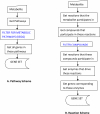Automated workflow-based exploitation of pathway databases provides new insights into genetic associations of metabolite profiles
- PMID: 24320595
- PMCID: PMC3879060
- DOI: 10.1186/1471-2164-14-865
Automated workflow-based exploitation of pathway databases provides new insights into genetic associations of metabolite profiles
Abstract
Background: Genome-wide association studies (GWAS) have identified many common single nucleotide polymorphisms (SNPs) that associate with clinical phenotypes, but these SNPs usually explain just a small part of the heritability and have relatively modest effect sizes. In contrast, SNPs that associate with metabolite levels generally explain a higher percentage of the genetic variation and demonstrate larger effect sizes. Still, the discovery of SNPs associated with metabolite levels is challenging since testing all metabolites measured in typical metabolomics studies with all SNPs comes with a severe multiple testing penalty. We have developed an automated workflow approach that utilizes prior knowledge of biochemical pathways present in databases like KEGG and BioCyc to generate a smaller SNP set relevant to the metabolite. This paper explores the opportunities and challenges in the analysis of GWAS of metabolomic phenotypes and provides novel insights into the genetic basis of metabolic variation through the re-analysis of published GWAS datasets.
Results: Re-analysis of the published GWAS dataset from Illig et al. (Nature Genetics, 2010) using a pathway-based workflow (http://www.myexperiment.org/packs/319.html), confirmed previously identified hits and identified a new locus of human metabolic individuality, associating Aldehyde dehydrogenase family1 L1 (ALDH1L1) with serine/glycine ratios in blood. Replication in an independent GWAS dataset of phospholipids (Demirkan et al., PLoS Genetics, 2012) identified two novel loci supported by additional literature evidence: GPAM (Glycerol-3 phosphate acyltransferase) and CBS (Cystathionine beta-synthase). In addition, the workflow approach provided novel insight into the affected pathways and relevance of some of these gene-metabolite pairs in disease development and progression.
Conclusions: We demonstrate the utility of automated exploitation of background knowledge present in pathway databases for the analysis of GWAS datasets of metabolomic phenotypes. We report novel loci and potential biochemical mechanisms that contribute to our understanding of the genetic basis of metabolic variation and its relationship to disease development and progression.
Figures




References
-
- Gieger C, Geistlinger L, Altmaier E, Hrabe de Angelis M, Kronenberg F, Meitinger T, Mewes HW, Wichmann HE, Weinberger KM, Adamski J. et al.Genetics meets metabolomics: a genome-wide association study of metabolite profiles in human serum. PLoS Genet. 2008;14:e1000282. doi: 10.1371/journal.pgen.1000282. 2008/12/02 edn. - DOI - PMC - PubMed
-
- Demirkan A, van Duijn CM, Ugocsai P, Isaacs A, Pramstaller PP, Liebisch G, Wilson JF, Johansson A, Rudan I, Aulchenko YS. et al.Genome-wide association study identifies novel loci associated with circulating phospho- and sphingolipid concentrations. PLoS Genet. 2012;14(2):e1002490. doi: 10.1371/journal.pgen.1002490. - DOI - PMC - PubMed
Publication types
MeSH terms
Grants and funding
LinkOut - more resources
Full Text Sources
Other Literature Sources

